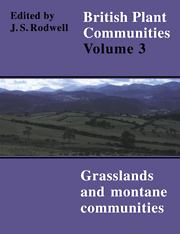Book contents
- Frontmatter
- Contents
- List of Figures
- Preface and Acknowledgements
- Preamble
- Mesotrophic Grasslands
- Community Descriptions
- Calcicolous Grasslands
- Community Descriptions
- Calcifugous Grasslands and Montane Communities
- Community Descriptions
- Index of Synonyms to Grasslands and Montane Communities
- Index of Species in Grasslands and Montane Communities
- Bibliography
Key to Calcicolous Grasslands
Published online by Cambridge University Press: 04 July 2020
- Frontmatter
- Contents
- List of Figures
- Preface and Acknowledgements
- Preamble
- Mesotrophic Grasslands
- Community Descriptions
- Calcicolous Grasslands
- Community Descriptions
- Calcifugous Grasslands and Montane Communities
- Community Descriptions
- Index of Synonyms to Grasslands and Montane Communities
- Index of Species in Grasslands and Montane Communities
- Bibliography
Summary
With something as complex and variable as vegetation, no key can pretend to offer an infallible short cut to diagnosis. The following should therefore be seen as a crude guide to identifying the types of calcicolous grassland in the scheme and must always be used in conjunction with the data tables and community accounts. It relies on floristic (and, to a lesser extent, physiognomic) features of the vegetation and demands a knowledge of the British vascular flora and some bryophytes and lichens. It does not make primary use of any habitat features, although these can provide a valuable confirmation of a diagnosis.
Because the major distinctions between the vegetation types in the classification are based on inter-stand
frequency, the key works best when sufficient samples of similar composition are available to construct a constancy table. It is the frequency values in this (and, in some cases, the ranges of abundance) which are then subject to interrogation with the key. Most of the questions are dichotomous and notes are provided at particularly difficult choices or where confusing mosaics and zonations are likely to be encountered.
Samples should always be taken from homogeneous stands and be of 2 x 2 m or 4 x 4 m according to the scale of the vegetation or, where complex patterns occur, of identical size but irregular shape. Very small stands can be sampled in their entirety.
1 Grasslands with one or more of Bromus erectus,
Brachypodium pinnatum or Avenula pubescens constant at more than 10% cover 2
Above species generally no more than occasional and never more than 10% cover 12
2 Sesleria albicans present
CG8 Sesleria albicans-Scabiosa columbaria grassland
Avenulapubescens sub-community
Sesleria albicans absent 3
3 Bromus erectus constant with Brachypodium pinnatum very rare
CG3 Bromus erectus grassland
Bromus erectus absent or, if present, then with Brachypodium pinnatum also present 7
4 Festuca ovina always frequent and rarely accompanied or replaced by F. rubra and/or F. arundinacea; Lotus corniculatus, Prunella vulgaris, Cirsium acaule,
Briza media and Linum catharticum frequent 5
Festuca ovina rare but F. rubra constant and F. arundinacea frequent, both sometimes in abundance; above dicotyledons rare
CG3 Bromus erectus grassland
Festuca rubra-Festuca arundinacea subcommunity
- Type
- Chapter
- Information
- British Plant Communities , pp. 117 - 124Publisher: Cambridge University PressPrint publication year: 1992

